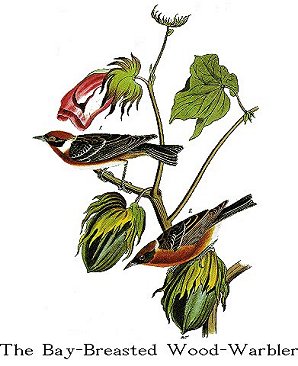
| Family VIII. SYLVICOLINAE. WOOD-WARBLERS. GENUS II. SYLVICOLA, Swains. WOOD-WARBLER. |
Next >> |

Family |
THE BAY-BREASTED WOOD-WARBLER. [Bay-breasted Warbler.] |
| Genus | SYLVICOLA CASTATEA, Wils. [Dendroica castanea.] |
This species does not breed in the United States, or if it does, must spend
the summer in some of the most remote north-western districts, so that I have
not been able to discover its principal abode. It merely passes through the
better known portions of the Union, where it remains for a very short time.
There is something so very uncommon in its appearance in different States, that
I cannot refrain from briefly mentioning it. It is sometimes found in
Pennsylvania, or the State of New York, as well as in New Jersey, as early as
the beginning of April, but is only seen there for a few days. I have shot some
individuals at such times, when I observed them employed in searching for
insects and larvae along the fences bordering our fields. At other times I have
shot them late in June, in the State of Louisiana, when the cotton-plant was
covered with blossoms, amongst which they were busily searching for food. The
Bay-breasted Warbler, however, has so far eluded my inquiries, that I am unable
to give any further account of its habits.
BAY-BREASTED WARBLER, Sylvia castanea, Wils. Amer. Orn.,
vol. ii. p. 97.
SYLVIA CASTANEA, Bonap. Syn., p. 80.
BAY-BREASTED WARBLER, Sylvia castanea, Nutt. Man., vol. i. p. 382.
BAY-BREASTED WARBLER, Sylvia castanea, Aud. Orn. Biog.,
vol. i. p. 358.
Outer three quills almost equal, fourth considerably shorter; tail slightly
emarginate. Male with the upper part of the head, the fore-neck, and the sides,
chestnut-read; forehead and cheeks, including a small space over the eye, deep
black, behind which is a transverse patch of yellowish-white on the sides of the
neck; back bluish ash-grey, streaked with black; tips of the secondary coverts
and first row of small coverts white; quills and tail-feathers brownish-black,
edged with grey, the outer three of the latter with a white patch on the inner
web, near the end; middle of breast, abdomen, and lower tail-coverts white,
tinged with reddish. Female similar to the male, but with the tints fainter,
especially the chestnut of the head and throat, which are converted into light
brownish-red.
Male, 5 1/4, 11.
From Texas northward. Rather common. Migratory.
THE HIGHLAND COTTON-PLANT.
GOSSIPIUM HERBACEUM, Linn., Syst. Nat., vol. ii. p. 462.
--MONADELPHIA POLYANDRIA, Linn.--MALVACEAE, Juss.
This species, commonly known in America, is distinguished by its five-lobed
leaves and herbaceous stem.
| Next >> |